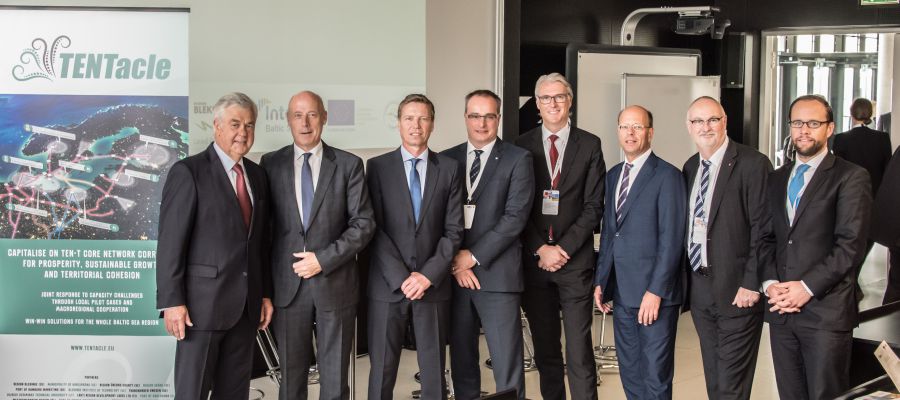
Published 30 Sep, 2016
The effects of the Fehmarnbelt fixed link on commodity flows and economic development
Fehmarnbelt Days 2016: “More than just a piece of concrete” – The effects of the Fehmarnbelt fixed link on commodity flows and economic development
Experts of politics and industry engaged in a lively discussion on 21 September 2016 during the Fehmarnbelt Days in Hamburg’s HafenCity University. The panel discussion, which was organised by Port of Hamburg Marketing (HHM) as a partner in the EU Interreg Baltic Sea Region Programme project TENTacle, was dominated by one question: What effects will the Fehmarnbelt fixed link have on intermodal freight flows between Northern Germany and Scandinavia? Yet all were unanimous on one point: The tunnel is coming.
Among the 120 participants were such high-ranking politicians and business representatives from Germany, Denmark and the EU as Pat Cox, EU coordinator for the Scandinavia-Mediterranean transport corridor of the Trans-European Transport Network (TEN-T). As Ingo Egloff, CEO of HHM, mentioned in welcoming the participants, their attendance underlined the importance of the topic. In his keynote speech Senator Frank Horch, Hamburg’s Senator for Economy, Transport and Innovation, explained the very high priority accorded to the Fehmarnbelt fixed link in planning by the Hamburg state government (Senate): “The Hamburg and Copenhagen metropolitan regions are natural partners: Building the tunnel will enable them to pool their strengths. This is equally important for the population, commerce and also universities in the two regions and for the whole of Northern Germany and Southern Scandinavia.”
Michael Svane, CEO of the Danish Transport Federation and Infrastructure Policies, threw light in his speech on the Fehmarnbelt fixed link project from the Danish point of view. Svane, who described himself as a true believer of cooperation and competition, primarily emphasized the immaterial aspects of such a tunnel: “This will not just be a piece of concrete, but will involve increased potential for companies, for the world of politics and above all for the population.” From his point of view there may be some losers due to the tunnel, but a distinctly larger number of winners. “The Fehmarnbelt fixed link will be a game changer, as proved by other crossings in Denmark like the Öresund Bridge to Sweden: A new multimodal transport corridor will strengthen cross-border trade, on the one hand, and improve quality of life for people in the regions, on the other.”
Intensive involvement of the civil public is the key
Following the keynote introductions, five speakers gave their views on the possible effects of the tunnel during a panel discussion moderated by Jens Assmann of the Hamburg Chamber of Commerce. Kurt-Christoph von Knobelsdorff, Schleswig-Holstein’s Deputy Permanent Secretary for Economic Affairs, and Frank Limprecht, Regional Head of Large-scale Projects at DB Netz, explained the extensive processes for involving the civil public in the planning of the tunnel and the German rail connections on a voluntary basis, for example through regional Round Tables and the general dialogue forum on the Fehmarnbelt fixed link. “Since major construction projects are usually perceived critically at the outset by wide sections of the population, such intensive and time-consuming involvement is a necessary and a good investment,” said Limprecht. In addition, citizens affected are able to receive a hearing through such statutorily prescribed processes of involvement as planning approval procedures. Well over 10,000 objections, for instance, are expected to be received by the Kiel planning authorities in the course of the plan revision procedure on the Belt Tunnel. Both representatives seemed to be confident, however, that construction of the tunnel and the related rail connection in Germany could start by 2020 at latest. “Let’s get it done” was von Knobelsdorff’s call to conference delegates.
What shifts may be expected to existing and forecast transport flows?
Prof Dr Sebastian Jürgens, Managing Director of Lübecker Hafen-Gesellschaft (Port of Lübeck) and Heiko Kähler, Managing Director of ferry operator Scandlines, are more critical about construction of the tunnel. For both, this entails a serious alteration of the conditions under which they do business. They therefore called a level playing field and fair and equal conditions for competition from the politicians. Despite the construction of a tunnel, infrastructure for linking the ports and for intermodal services should not be neglected. Jürgens reminded his hearers that in the overall view of the transport flows the tunnel should not lead to a modal shift in favour of the truck.
Jürgens is convinced that even after completion of the tunnel, he will still be able to operate successfully. The Port of Lübeck aims to evolve as a logistics and intermodal hub, and will therefore require a direct rail link to the tunnel, something not so far envisaged in Deutsche Bahn’s planning. Scandlines aims to broaden its range with new ferry routes, and will also deploy additional environment-friendly hybrid ferries to maintain its services on the Puttgarden-Rødby route.
Michael Svane concluded by emphasizing once again that in a market-driven society, only competition, plus cooperation will be appropriate to master the swiftly changing conditions in the light of new energy and environmental requirements. “Customers will always be persuaded by good intermodal concepts – also in Lübeck”, Svane assured Jürgens. At the same time, he held out the prospect of five new Danish customers, whom he intends to secure for the Port of Lübeck – a good example for stronger cooperation between German and Danish players. “Eventually, the tunnel concerns not only these two regions, but will bring future stimuli for the intermodal transport sector throughout the European Union,” concluded Svane.